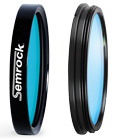
Semrock Optical Filters

Filter wheels are frequently an integral part of multichannel fluorescence microscope systems. Installed in the excitation and emission signal pathways and populated with wavelength-selecting optical filters, filter wheels provide microscopists with high-speed, discreet control of the color of light either exciting the specimen or quantified by the detector/camera. As the popularity of live cell microscopy continues to increase, researchers are demanding that their microscope systems capture images at faster and faster rates to improve temporal resolution, record dynamic events, and control photobleaching of specimens. Filter wheels can also be used as shutters by rotating to a position that contains a blocking disk instead of an optical filter. The speed of wavelength switching and shuttering is determined by the mechanical specifications of the filter wheel and is primarily dictated by the drive motor and the mass of the wheel that this motor rotates at high speeds.
What if you want to go “faster than ever,” or want to confirm that you are operating your filter wheel at the fastest possible speed? It is important to recognize that any given filter wheel is capable of differing top speeds based solely on the mass of optical filters installed. An empty and thus lighter filter wheel is capable of faster change speeds than a fully populated, heavier filter wheel. To find the upper speed limit of a populated wheel, end users normally increase the speed of the wheel in a step-wise fashion until a run-time error is returned (typically because the wheel cannot successfully start and stop rotating without overshooting the desired position), and then decrease the speed setting by one or two steps.
To optimize a filter wheel and obtain the fastest position switching speeds, the total rotational mass of the filter wheel system must be minimized. The motor torque specification and hub design/mass are fixed and cannot be easily changed/improved by the operator. This leaves the optical filters and their mounting fixtures as the only variable source of mass for a given filter wheel – fortunately these can be easily optimized by the end-user.
You can perform several actions to minimize the mass of a filter wheel. First, install only those filters that are needed for the application at hand. The filters should be appropriately staggered with open positions in the wheel to maintain rotational balance. Second, choose the lightest possible filters. Semrock filters utilize our patented BrightLine® technology where hard-coated interference filter layers are applied to a single glass substrate. For Semrock filters, that single piece of glass is also relatively thin at 2 mm with a low overall mass compared to multi- or thick-substrate filter design. Our hard-coated, no burn-out optical filter technology applied to thin substrates provides a filter wheel system that will offer consistent, fast performance over many years.
Finally, Semrock has worked with Sutter Instruments to design and introduce an integrated filter wheel mounting ring for our optical filters that is threaded to match the openings in a Sutter filter wheel hub. With this inclusive mounting system, the optical filter and threaded retaining ring are incorporated into a single component (see Figure 1). Sutter filter wheels traditionally have been designed to accept optical filters up to 9 mm in thickness with each filter wheel position incorporating a mounting hardware system that consists of a filter cup and retaining ring. The new Semrock/Sutter integrated threaded ring solution is designed to be installed after removing the filter cup and retaining ring. By eliminating the need for the cup and ring hardware, a Semrock optical filter and integrated threaded ring mount assembly actually weighs less than the cup and ring it replaces.

Figure 1: Left: Traditional mounted optical filter. Right: New Semrock/Sutter threaded ring mount
The result is a filter wheel with a net reduction in mass after the filters are installed. (see Table 1) The Sutter threaded ring option is available for all Semrock “Pinkel” (single-band exciters with multiband emitter) and “Sedat” (single-band exciter and emitters) multicolor filter sets. The option is denoted by the suffix “-STR” appended to the catalog part number and is accompanied by a nominal $20 price premium per filter.
By utilizing the weight saving tools outlined above, an end user can ensure that their Sutter filter wheel is operating at peak performance to obtain the maximum allowable speed for their system.
Table 1: Mass contribution of filters and mounting hardware for a fully populated, 10 position, 25mm filter wheel
| Configuration | Mass |
| No filters installed. ‘Out of the box’ configuration with mounting hardware installed. | 34g |
| Normal filters installed , includes mounting hardware (Qty:10) | 60g |
| Semrock filters with integrated threaded ring mount installed (Qty:10). No additional mounting hardware needed or installed | 26g |